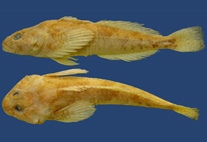Abstract
Cottus gratzianowi, a new cottid species, is described from material collected in the Ukhtomitsa River in the Onega River drainage, White Sea basin. It differs from its congeners in Europe east of the Meuse except C. koshewnikowi by having no transverse dark bands on the pelvic fin, a single chin canal pore, an incomplete lateral line not reaching behind the anal-fin insertion, and the position of the lateral line which is located considerably above the mid-line of the flank. From C. koshewnikowi distributed in the Volga (Caspian basin), Pechora, and Northern Dvina rivers (Arctic basin), C. gratzianowi sp. nov. can be distinguished by a combination of character states, the most differentiating are as follows: a larger eye (horizontal diameter 23−28% HL, equal to or exceeding snout length vs. 16−25% HL, less than snout length), a rounded caudal fin (vs. commonly truncated), frequent presence of one to three branched rays in median part of the pectoral fin (vs. usual absence), an interrupted supratemporal canal commissure with 4 pores (vs. non-interrupted, with 3 pores), abdominal vertebrae commonly 10 (vs. 11), and contrasting black blotches on all fins including pelvic and anal fins (vs. no blotches on pelvic and anal fins).

